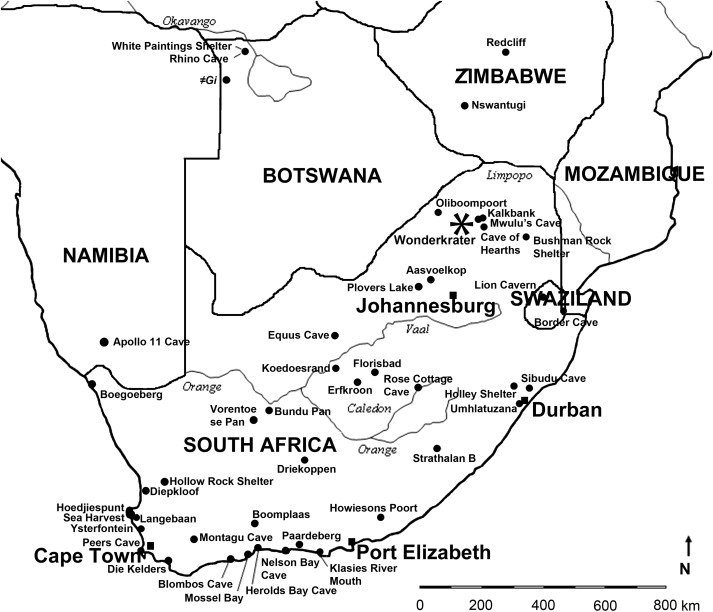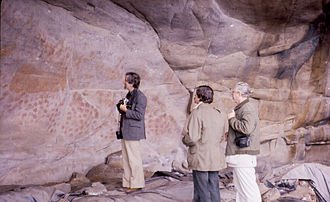
Dear Reader
In this following series of posts we are covering the Later Stone Age of South Africa, I highly encourage you to please read the Introduction, Historical Background, Advances in Later Stone Age, Climatic conditions of the LSA in South Africa, Elements characteristic of the Later Stone Age and The Later Stone Age sequence posts to this series to bring you update to date with the information and terminology we have covered so far.
Early Later Stone Age, Robberg and Robberg-like microlithic assemblages
(ca 22 000 BP to 12 000 BP)
Dating (more than 22 000 BP to 12 000 BP)
Transitional assemblages found between Middle Stone Age (MSA) and Later Stone Age (LSA) technologies are rare, and some of these have not yet been reliably dated. Where early LSA assemblages occur in a developing sequence between MSA and developed LSA horizons such as at Border Cave, the transition appears to be between 40 000 and 30 000 BP. However, the earliest dates for the early LSA assemblages of more than 25 000 BP originate from sites for which, at present, we have neither additional supporting dates nor palaeoclimatic data, or these early dates are attributed to sites where the stratigraphy is problematic (Mitchell 1988:253-257).
The timing of this transition to fully developed LSA technologies varies considerably, but the latest deposits with definite affinities to early LSA date to 12 000 BP. In most of these later assemblages bladelet production is intensified, with a higher percentage of bladelets being present than in more informal assemblages (ie those preceding 25 000 BP).
The character of the early LSA assemblages
Our samples of these industries is still small and the dates are inconsistent, making a synthesis of this period difficult. The transition from MSA to LSA technologies can be dated to between 30 000 and 20 000 BP. Arguments for an even earlier date, between 40 000 and 60 000 BP, have still to be substantiated.
Extensive excavations of various sites, in particular those with a long sequence of occupation deposits in the Cape, the Free State and Gauteng, has led to the recognition of the existence of an early LSA phase at some sites (predating the Oakhurst and Wilton). This stage is represented in the southern and eastern Cape by the Robberg Industry (named after the Robberg Peninsula on which Nelson Bay Cave is located and where the Robberg was first recognised). This earlier phase of the LSA was also present at sites such as Melkhout boom, Byneskranskop in the south-western Cape, Elands Bay Cave on the west Cape coast, and possibly a few other sitess (Umhlatuzana and Shongweni in Kwa-Zulu Natal; Equus Cave in the northern Cape; Heuningneskrans and Bushmans Rock Shelter in Mpumalanga).
Early LSA assemblages are also present in Lesotho and Swaziland. In the Free State this earlier industry is recognised at Rose Cottage Cave. The Rose Cottage Material and the material from Sehonghong in Lesotho are comtemporaneous and very similar to the Robberg Industry; however, they have not been formally included in the Robberg industry and are often referred to as Early LSA (ELSA) (Wadley 1993:265). Early microlithic assemblages are also present at Cave James Shelter in Gauteng (Wadley 1993). If the single date of 29 000 BP obtained from charcoal in a stone-lined hearth is corroborated, this assemblage in the Magaliesburg area represents one of the earliest expressions of the LSA.
- This early expression of the LSA definitely reflects the character of the LSA:items found at these sites include ostrich eggshells items and other material culture associated with San hunter-gatherer ethnography (Mitchell 1988:6). Typical LSA artefacts that appear in small numbers include ostrich eggshell beads and water containers, polished bone points and link-shafts, tortoise shell bowls, as well as a few small bored stones or other groundstone work.
- Typical MSA characteristics (such as faceted platforms and radially prepared cores) are uncommon in the early LSA assemblages. Points with secondary flaking are absent or rare.
- The early LSA also has a very low percentage of formally retouched tools.
- Bladelet cores and unretouched bladelets smaller than 25 mm are generally present. Concentrations of bladelets sometimes occur in the Robberg Industry levels at Boomplaas, suggesting that they may have been kept in some kind of container or bag. The function of these bladelets is not yet known. They could have been used as inserts in spears (for in the hunting of large game) or as inserts in other composite implements.
- Scrapers are small(<25mm).
- Fine-grained materials such as quartz , quartz crystals and other crypto-crystalline material are preferred.
- At sites such as Elands Bay Cave in the Western Cape and Umhlatuzana in Kwa-Zulu Natal, the presence of large, naturally backed knives on hornfels before 12 000 BP indicates elements of the nonmicrolithic Oakhurst.
Images are link to their sources in their description and references are stated within the text.
Thank you for reading
Thank you @foundation for this amazing SteemSTEM gif




